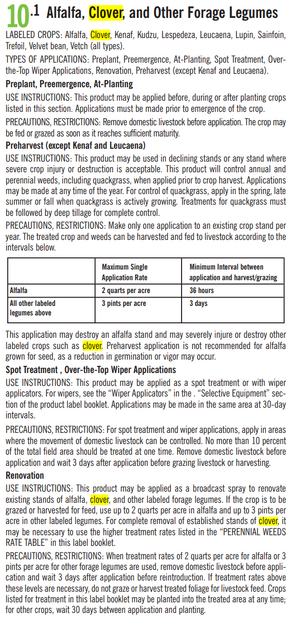Having said that, here is my thoughts on clover in a deer management program. Perennial clover is the anchor of my program. I find it is a low cost way to produce a lot off deer food. I no longer do much weed control in clover. I have found, over time, that nature abhors a monoculture. I find it best to bend nature slightly to favor deer, but the more you bend it, the higher the cost in money and time and the less marginal benefit you get, and in some cases, it works against deer.
I have become much more weed tolerant over the years. "Weeds" are just plants growing where you don't want them to grow. Many plants, considered by farmers to be "weeds" are great deer food and beneficial to both deer, wildlife in general, and the soil. Don't get me wrong, there are problematic weeds that do need to be dealt with if a particular weed is dominating, but a healthy mix if weeds in clover tended to work together to benefit deer.
So, my process starts with selecting a perennial clover. In my area, ladino goes dormant during the summer. Mixing it with chicory can give more coverage. Durana, only goes dormant for very short periods during dry summers here, and never goes dormant during summers with better rain. The particular clover chosen depends on your location. Durana is slow to establish, but once established is more persistent and drought resistant than ladino.
Next, I use best practices to start with a weed free field. I burn down in the fall and plant Durana with a Winter Rye cover crop. The first spring I mow the WR back to 6"-8" each time it gets much over a foot and begins to shade out the Durana. This keeps the WR alive and taking up space and impacting weeds until it dies naturally and gives the Durana time to establish.
After that first spring, I don't worry about weeds in my clover. During the summer, you can't even tell it is a clover field. A variety of weeds abound. Some benefit deer and others don't but they shade the clover underneath and don't bother deer at all. I've found that weedy fields tend to get more use. I think this is likely because of the bit of cover that taller weeds provide. As fall comes around, right before our archery season, I mow the summer weeds. The cool nights and fall rains favor the clover it comes bouncing back in the fall and it looks like a clover field again.
Over time, individual clover plants are always dying and releasing N while new plants are being born. The N makes the field more and more attractive to grasses over time. Eventually, the time comes (about 10 years with Durana) where the clover component of the field gets low enough to restart. At this point, I like to rotate into a crop that uses the N banked by the clover. I'll sometimes use buckwheat in the spring, or brassica and cereal in the fall.
I'll then start over and replant clover. When I first started, I used all kinds of methods to keep a monoculture of clover. The fields looked like magazine covers but had no more value for deer. I used cleth, 24db, and even gly with a wicking bar to keep them "clean". I mowed regularly as well.
I've learned that what looks "good" to man, rarely benefits deer or other wildlife.


